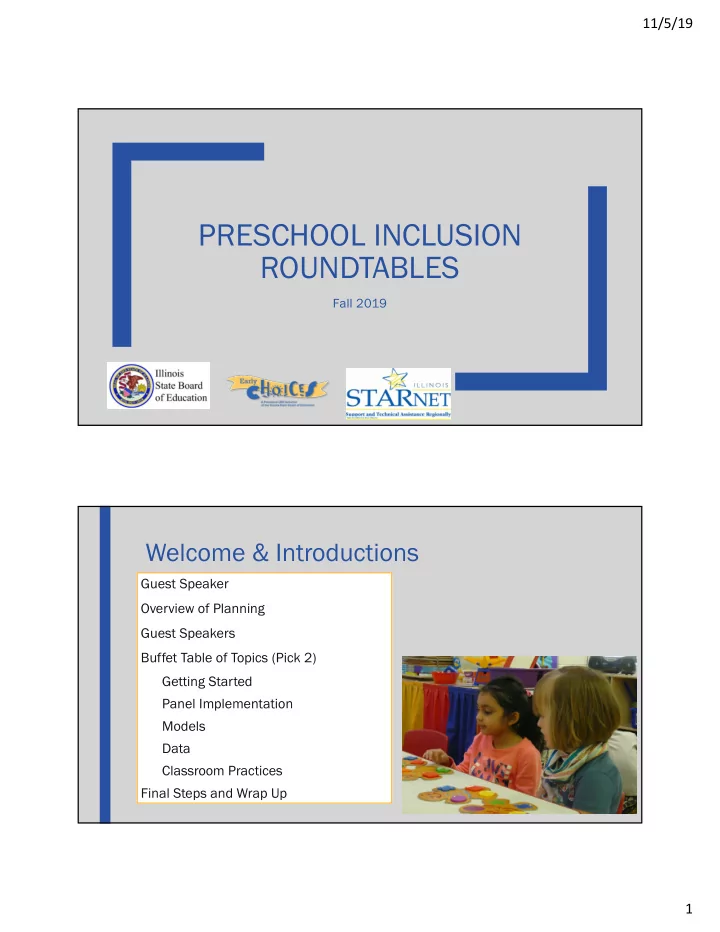

11/5/19 PRESCHOOL INCLUSION ROUNDTABLES Fall 2019 Welcome & Introductions Guest Speaker Overview of Planning Guest Speakers Buffet Table of Topics (Pick 2) Getting Started Panel Implementation Models Data Classroom Practices Final Steps and Wrap Up 1
11/5/19 Inclusion in early childhood programs refers to including children with disabilities in early childhood programs, together with their peers without disabilities; holding high expectations and intentionally promoting participation in all learning and social activities, facilitated by individualized accommodations; and using evidence-based services and supports to foster their development (cognitive, language, communication, physical, behavioral, and social-emotional), friendships with peers, and sense of belonging. This applies to all young children with disabilities, from those with the mildest disabilities, to those with the most significant disabilities. The vision of inclusion in early childhood programs and recommendations provided in the policy statement build on the principles and definition set forth in the joint position statement from the National Association for the Education of Young Children and the Division of Early Childhood of the Council for Exceptional Children. 2
11/5/19 GUEST SPEAKERS 3
11/5/19 Invited to Roundtables if: ■ Less than 10% of students, ages 3 through 5 with IEPS attend a regular early childhood program and receive the majority of special education and related services in the regular early childhood program. ■ 50% or more of children aged 3 through 5 with IEPs attend a separate special education class, separate school, or residential facility. Inclusive Inquiry Cycle 4
11/5/19 Timeline Where are we in the process of developing high quality inclusion? ■ Where are we now with providing related services and specialized instruction within the regular early childhood programs to meet IEP minutes? ■ Where are we with reducing the number of children who are only served in self contained classrooms? 5
11/5/19 SPP 6 6A: IS : ISBE E Early C Childhood S Students A Ages 3 3-5 i in R Regular E Early Childhood P Programs a and R Receiving t the M Majority o of S Special E Education Related S Services i in t that L Location 50 46.3 45 43.5 43.6 44.8 42.5 41.6 40.76 40 40 37.98 35.41 33.93 35 32.81 32.24 32.2 32.8 32.6 32.7 32.4 32.5 32.2 32.3 30 30.73 25 2010-11 2011-12 2012-13 2013-14 2014-15 2015-16 2016-17 2017-18 State Actual State Target National Actual SPP 6 6B: P : Percent o t of IS ISBE E Early C Childhood S Stu tudents ts Ages 3 3-5 i in a a S Separate S Special E Educati tion 50 40 31.1 32.85 31.2 31 30.9 30.8 30.7 30.6 30 30.04 29.55 29.15 28.21 26.76 25.6 25.6 25.2 26.7 24.94 31.25 26.326 20 10 0 2010-11 2011-12 2012-13 2013-14 2014-15 2015-16 2016-17 2017-18 State Actual State Target National Actual 6
11/5/19 750 LEAs Serving Children 3-5 2016-17 EE Data LEAs Serving Childre ren with IEPs A wi th IEPs Aged 3 ged 3-5 & Indicator or 6 203 283 Meet 6A & 6B Meet 6A, not 6B Meet 6B, not 6A Do Not meet 6A or 6B 211 2016-17 EE data 52 749 LEAs Serving Children 3-5 2017-18 EE Data LEAs Serving Childre ren with IEPs A wi th IEPs Aged 3 ged 3-5 & Indicator or 6 171 Meet 6A & 6B 298 Meet 6A, not 6B Meet 6B, not 6A Do Not meet 6A or 6B 228 2016-17 EE data 51 7
11/5/19 Comparison over Last two years of data 350 300 250 200 150 100 50 0 Meet 6A & 6B Meet 6A, not 6B Meet 6B, not 6A Do Not meet 6A or 6B 2017-18 data 2016-17 data IMPLEMENTATION PANEL 8
11/5/19 Buffet – What topic do you want learn more about? • Panel Implementation • Getting Started • Classroom practices to support inclusion • Models- what do you need to implement? • Data PANEL: IMPLEMENTATION 9
11/5/19 Getting Started ■ What are the first steps? ■ How do you gather stakeholders? ■ What resources are available to me? CLASSROOM PRACTICES TO SUPPORT INCLUSION 10
11/5/19 MODELS OF IMPLEMENTATION What model do I use? What teacher qualifications are needed? Who are my community partners? What about related services? Data ■ Review Indicator 6 Data ■ Supports and Resources for accurate data ■ Data Sleuthing ■ Review Data Cycle Planning and other sources of data to support planning 11
11/5/19 Plan of Action ■ Meet with your team if you have one or your tablemates to discuss: – What did you learn from the buffet line topics you went to? – What inspired you? – What are some action steps you want to note? – Who do you need to talk to back at your district or building to move ahead? WHAT MAKES INCLUSION WORK? 12
11/5/19 Inclusion Elevator Speech What Why How How are we moving forward What does Why is inclusion to increase inclusion mean important for our access for our program? preschool participation and program? supports for young children with disabilities? First steps? Timeline Reminders 13
Recommend
More recommend